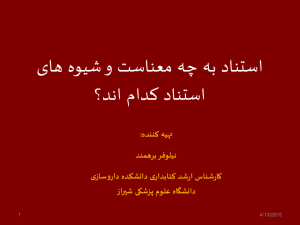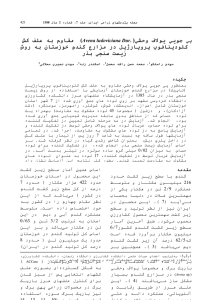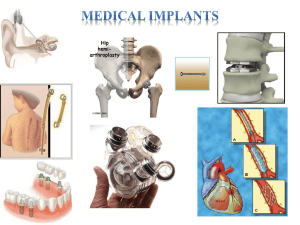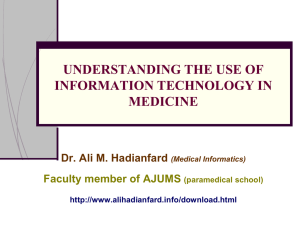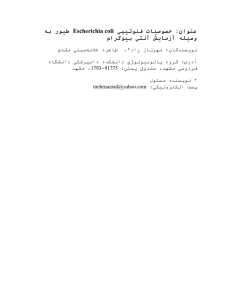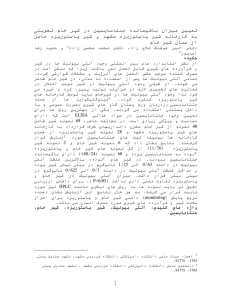مسایل اخلاقی در استفاده از حیوانات آزمایشگاهی در تحقیقات علوم زیستی
advertisement
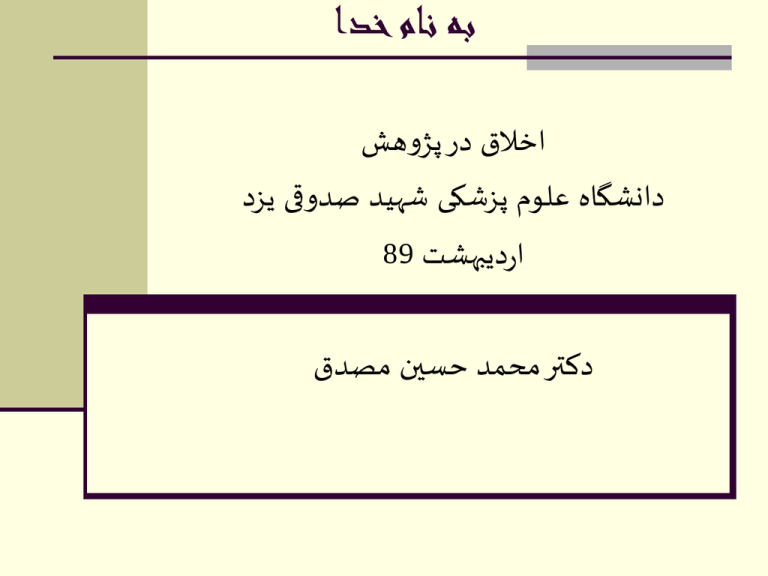
به نام خدا اخالق در پژوهش دانشگاه علوم پزشکی شهید صدوقی یزد اردیبهشت 89 دکتر محمد حسین مصدق مسایل اخالقی در استفاده از حيوانات آزمايشگاهي در تحقيقات زيست پزشکي Mankind has been using animals already for a long time for food, for transport and as companion. The use of animals in experimental research parallels the development of medicine, which had its roots in ancient Greece (Aristotle,Hippocrate). It had its roots in ancient Greece where Aristotle and Hippocrate laid down their knowledge on structure and function of the human body in their respective Historia Animalium and Corpus Hippocraticum, mainly based on dissections in animals. Galen (130–201 AD), physician of the Roman emperor Marcus Aurelius, performed physiological experiments on pigs, monkeys and dogs, which provided a basis for medical practices also in the centuries thereafter. After Galen, experimental science stopped till the beginning of the Renaissance when Vesalius took up the empirical approach, starting with anatomical studies. Later on, physiological studies were also performed. With the Cartesian philosophy in the 17th century, experiments on animals could be performed without great moral problems. The French philosopher Rene ´ Descartes (1596–1650) stated that living systems could be understood on pure mechanical principles. The discovery of anaesthetics and Darwin’s publication on the Origin of Species in 1859, defending the biological similarities between man and animal, contributed to the increase of animal experimentation. Claude Bernard published his book ‘Introduction a ` l’e ´ tude de la me ´ decine expe ´ rimentale’ in 1865, introducing methodology as a tool for the design of physiological experiments. The development of microbiology caused an increase in the use of animals, due to Koch’s ‘Postulates’ where it is stated that pathogenicity of a microorganism can be proven after successfully infecting healthy, susceptible animals. The development of biomedical disciplines as pharmacology, toxicology and immunology caused a sharp increase in the use of animals in the 20th century. From the early 1980s, a decrease started probably due to public awareness and strict legislation on animal use, the development of animal ethics committees and an improved quality of the animals. However, in last decades,use of animals started to increase again, mainly due to the development of genetically modified animals, which has caused an increase in numbers of mice used of more than 23% per year, not only due to growth in the numbers of these animals in research but also to the large number of mice necessary to create each genetically modified line, such as breeding males, donor females, vasectomized males and pseudo- pregnant recipient females. Furthermore, nontransgenic and wild-type littermates may be produced that are not suitable for research or further breeding. Today, 75–100 million vertebrates per year are used in research and testing for a wide range of purposes. The major areas are drug research, testing of vaccines and other biological and cancer research, whereas about 30% of the animals are used for other purposes such as fundamental research, diagnostics, etc. Mice and rats are the most frequently used animal species. In many European countries, it is mandatory by national law to grade the level of discomfort for animals in experiments in minor, moderate and severe. On average, 50% of the laboratory animals experience minor discomfort (eg single blood sampling), 30% moderate (eg recovery from anaesthesia) and 20% severe (eg toxicity tests). The increasing demand for high standard animal models together with a critical view on the use of animals led to the development of Laboratory Animal Science in the 1950s, a field that can be defined as a multidisciplinary branch of science, contributing to the quality of animal experiments and to the welfare of laboratory animals. Laboratory Animal Science includes the biology of laboratory animals and their environmental requirements, genetic and microbiological standardization, prevention and treatment of diseases, improvement of experimental techniques, anaesthesia, analgesia and euthanasia, alternatives to animal experiments and ethics. • Guiding principles are the three R’s of Replacement, Reduction and Refinement, launched by Russell and Burch in 1959 in their book ‘The Principles of Humane Experimental Technique’.3 Replacement means the substitution of living animals by in vitro techniques (eg cells, tissues), computerized models, etc. Reduction means decrease of the number of animals used by standardization of the animal in terms of genotype and microbiological quality, of the experimental procedures and of the environment in terms of standardized food and climate in the animal room. Furthermore, the number of animals per experimental group can be more accurately estimated by using statistics prior to the experiment, for example, power analysis. Refinement means decrease in discomfort by translating the behavioural and physiological needs of the animal into adequate housing and husbandry, by providing adequate anaesthesia, analgesia and care, by guaranteeing skills of the researcher/animal staff, which can be achieved by education and training, by improving experimental procedures and by determining a human end point, where the animal can be euthanized to prevent unnecessary suffering. Furthermore, the necessity of certain animal experiments might be argued, such as in cosmetic testing, LD 50 tests, tests for military defence purposes, teaching, etc. Undoubtedly, activities of the general public such as protection organizations have contributed to legislative regulations for the protection of animals used for experimental purposes. The first law, the Cruelty to Animals Act, was adopted by the UK parliament in 1876. Since then, other countries have included provisions in their laws as to protect experimental animals. On a European level, two important documents controlling the use of animals in experiments were issued, In 1985 the Convention for the Protection of Vertebrate Animals used for Experimental and other Scientific Purposes (ETS 123) of the Council of Europe. In 1986 the Directive (Instruction) for the Protection of Vertebrate Animals used for Experimental and other Scientific Purposes (86/609/EEC) of the EU, based on ETS 123, but more stringent. The Directive applies to vertebrate animals used in experiments likely to cause pain, suffering, distress or lasting harm, covering also the development of genetically modified animals with the risk of experiencing pain and distress. The Directive contains provisions on accommodation and care of experimental animals, on competence of researchers and animal staff, on alternatives to animal experiments, anaesthesia, euthanasia, statistics on animal experimentation and supply of animals. Animal experiments are considered acceptable only if the benefit of the proposed experiment outweighs the suffering of the animals. Ethical review of animal experiments will likely benefit the animal and improve the quality of animal-based research. As animal well being is a prerequisite for reliable experimental results, it is of highest importance to seek for methods and procedures that can reduce suffering of the animals and improve their welfare. •MRC Ethics guide, Medical research council, London •APA’s Guidelines for Ethical Conduct in the Care and Use of Animals •Australian code of practice for the care and use of animals for scientific purposes 7th Edition, 2004 • AND MANY OTHERS… نمونه های مشابه در سایر کشورها USA The UDSA is responsible for enforcing the Animal Welfare Act, amended in 1985. The Act applies to all research facilities: public or private, academic or industry based, whether or not they receive federal funds. All covered facilities must register with the USDA and report to the USDA verifying compliance and indicating the number and species of animals used by types of procedures (i.e. painless, pain relief given or not given because of scientific necessity). The USDA is required to inspect each facility at least annually. The inspections are unannounced. More frequent unscheduled inspections are made if significant deficiencies are identified. All registered facilities are also required to establish a Animal Care and Use Committee (IACUC) that reviews and approves procedures involving animals before they take place, and inspect facilities semiannually for compliance with the AWA. At least one member of the committee must be a veterinarian. At least one member must be a "public" member, not affiliated with the institution, who represents the general community interest in the care and treatment of the animals. The US Public Health Service has an animal welfare policy that applies to all federally funded institutions. The Public Health Service maintains a Guide for the Care and Use of Laboratory Animals. This guide is consistent with and similar to the AWA and applies to all vertebrate animals. The Public Health Policy and Government Principles Regarding the Care and Use of Animals states Whenever US Government Agencies develop requirements for testing, research or training procedures involving the use of vertebrate animals, the following principles shall be considered; and whenever these agencies actually perform or sponsor such procedures, the responsible institution shall insure that these principles are adhered to: · The transportation care and use of animals shall be in accordance with the Animal Welfare Act (7USC 2131 et seq.) and other applicable Federal laws, guidelines and policies. procedures involving animals should be designed and performed with due consideration of their relevance to human or animal health, the advancement of knowledge, or the good of the society · The animals selected for a procedure should be of an appropriate species and quality and the minimum number required to obtain valid results. Methods such as mathematical models, computer simulations, and in vitro biological systems should be considered. Proper use of animals, including the avoidance or minimization of discomfort, distress, and pain when consistent with sound scientific practices, is imperative. Unless the contrary is established, investigators should consider that procedures that cause pain or distress in humans beings may cause pain or distress in other animals. Canadian Council on Animal Care Guide, Vol.1, (2nd Edition )1993. Avilable online:http://www.ccac.ca/en/CCAC_Programs/Guidelines_ Policies/GDLINES/Guidelis.htm -Guidance on the Operation of the Animals (Scientific Procedures) Act 1986, Avilable online: http://www.archive.officialdocuments.co.uk/document/hoc/321/321-02.htm -Australian code of practice for the care and use of animals for scientific purposes, Avilable online: http://www.nhmrc.gov.au/publications/synopses/_files/ea16. pdf CCAC Programs -> Education Training, Avilable online: http://www.ccac.ca/en/CCAC_Programs/ETCC/Intr o-coretopics-Web11.htm -Animal Procedure Committee Education & Training Sub-Committee: Review of modular Training , Avilable online: http://www.apc.gov.uk/reference/apc-educationmodular-training.pdf - The University of Newcastle, Australia, 2007 Training Program, Research Animal Training Scheme, Avilable online: http://www.newcastle.edu.au/research/animal/doc s/RATS- program%20information.pdf تهيه و حمل و نقل حيوانات الف -قوانين معرفي گونه جديد به منطقه ب -نحوه اسارت حيوانات ج -نحوه نگهداري در اسارت د -چگونگي حمل و نقل شامل وسايل حمل و نقل و قفسها روشهاي نگهداري الف -مكان :شامل فضاي نگهداري ،شرايط قفسها ،نگهداري در فضاي باز ،تهويه ،فاضالب ،نور پردازي ،راههاي فرار در موارد اضطراري ب -امكانات :شامل غذا ،امكانات درماني ،شستشو نيروهاي اجرايي (مراقبتكنندگان حيوان) الف -آموزشهاي الزم براي حفظ سالمت حيوان و انسان ب -لباس و امكانات حفاظتي ج -عالقه به كار و امكانات رفاهي الزم د -آگاهي نسبت به اهميت موضوع پژوهش ه -اطالع از عاليم بيماري و سالمت حيوان وـ رعايت خصوصيات زندگي طبيعي حيوان در شرايط اسارت تا حد ممكن مانند اجتماعي بودن يا انفرادي بودن حيوان زـ آگاهي از وضعيت آبستني و شيردهي حيوان كاربران پژوهش و محققين الف -آگاهي از نوع ،جنس و ساير شرايط حيوان مناسب براي آزمايش ب -اطالعات الزم در مورد تاثير شرايط محيطي بر نتايج آزمايش ج -عدم استفاده از حيوانات بيمار در آزمايش پیشنهادها Products in Europe not tested on animals carry this symbol. وجود مرکزی در کليه ی دانشگاهها برای نطارت اخالقی بر محلهای نگهداری و کار بر روی حيوانات ،بطور دوره ای و سامانمند. الزام اخذ و تمديد دوره ای مجوز از سوی مراکز نگهداری و کار بر روی حيوانات. الزام گذراندن دوره ی کار بر روی حيوانات برای تمامی کسانی که به نحوی با حيوانات سروکار دارند ،بويژه پژوهشگران. بررسی اوليه ی پروپوزال و نظارت بر پژوهشهای شامل کار بر روی حيوانات از سوی کميته ی اخالقی ويژه. Monument for animals used in testing at Keio University The End مولوی می فرماید: زانباری پر از گندم اگر یک مشت بنمایی بدانکه جمله گندم را توان دانست ای دانا کليات تاريخ تحقيقات زيست پزشکي ونتايج ارزشمند مطالعات دانشمندان ،اهميت کاربرد حيوانات را در اين پژوهشها نشان مي دهد هنوز در راه شناخت وضعيت سالمتي و چگونگي رخداد بيماريها راهي طوالني در پيش است. علي رغم وجود روشهاي متنوع مطالعات آزمايشگاهي مانند علوم سلولي و ملکولي ،تنها راه براي يادگيري بيشتر مطالعه روي حيوانات زنده است. امروزمسائلي همچون آسايش ،حقوق ،رفاه حيوانات و رعايت اصول اخالقي کار با حيوانات ازمايشگاهي بسيار مورد توجه قرار گرفته است. کليات در کشورهاي مختلف دنيا انجمن هاي حمايت از حيوانات و کميته هايي درمراکز دانشگاهي و تحقيقاتي براي نظارت بر استفاده و مراقبت آنها فعاليت دارند. احساس مسئوليت در برابر حيوانات تحت آزمايش و توجه به رفاه وحقوق آنان از وظايف اخالقي هر پژوهشگر مي باشد. اين امر در صورتي محقق خواهد شد که پژوهشگران زندگي و نيازهاي طبيعي حيوانات مورد آزمايش و اصول اخالقي هر گونه پژوهش بر آنها را بشناسند و در اين زمينه آموزشهاي الزم را ببينند. کاربرد حيوانات انسان از گذشته هاي دور از حيوانات براي تغذيه ،حمل ونقل و....بهره مي برده است. استفاده از حيوانات در پژوهش به موازات پيشرفت علم طب طب ايران باستان و طب يونان ممنوعيت تشريح جسد در طب يونان باستان مطالعات فيزيولوژيک جالينوس ،بزرگترين متخصص طب تجربي ،بااستفاده از آزمايشات روي خوک ،ميمون و سگ ظهور اسالم نقطه عطفي در علم طب پس از ظهور اسالم ،مطالعات پزشکان نامدار ايراني درکالبد شناسي و فيزيولوژي با استفاده ازحيوانات تشريح ساختمان دستگاه عصبي توسط رازي از بزرگترين ومبتکر ترين پزشکان مسلمان ايراني با استفاده ازحيوانات شناخت آثار بسياري داروها با آزمايش روي حيوانات توسط رازي کاربرد حيوانات در اروپا بعد ازرنسانس مطالعات آناتوميک گسترده با استفاده از حيوانات توسط وزاليوس ،پدر علم تشريح در قرن هفدهم شکل گيري فلسفه کارتزين اعتقادات رنه دکارت کاربرد امروزي حيوانات در پژوهش ارزش و اهميت خاص استفاده از حيوانات آزمايشگاهي در پژوهشهاي زيست پزشکي اطمينان ازاثربخشي و ايمني داروهاي جديد ،واکسن ها وتکنيک هاي جراحي مدل حيواني دربرنامه هاي پژوهشي مانند فرآوري دارو ،بررسي فارماكوكينتيك آنها و تعداد زيادي از مطالعات فيزيولوژيكي کشف علل بيماريهاي شديد و کشنده ،راههاي در ماني و طرق جديد پيشگيري از بيماريها در قرن بيستم در قرن بيستم بهترين و مؤثرترين درمانهاي پزشکي با کشف وآزمايش آنتي بيوتيکها ،واکسنها ،جراحي قلب ،پيوند کليه و... از طريق استفاده ازحيوانات ميسر شده است. حمایت ازحیوانات از دهه 1950با تمايل به باالرفتن استانداردهاي مدلهاي حيواني خود به عنوان شاخه اي از علم منجر به بهبود کيفيت آزمايشات و رفاه حيوانات در سال 1959راسل وبروس سه قاعده اساسي درکار با حيوانات آزمايشگاهي گروه هاي حمايت از حيوانات در دنيا اولين قانون تحت عنوان ANIMAL ACTدر سال 1976 در انگلستان قانون حمايت از حيوانات بر اساس اين قوانين محقق تنهادر محدوده هاي خاص و در ارتباط با امر تحقيق مي تواند روي حيوان آزمايش نمايدو آسايش حيوانات اولين چيزي است که در چگونگي اداره آزمايشات بايد مورد توجه قرار گيرد . نظارت بر کار با حیوانات آزمایشگاهي صدورگواهينامه هاي مخصوص براي افرادي که در تحقيقات خود از مدل حيواني استفاده مي کنند کميته هاي ارزيابي اخالقي پژوهش و نظارت بر نگهداري وتحقيقات برحيوانات آزمايشگاهي در دانشگاهها و مراکز تحقيقاتي دنيا نظارت بر کار با حیوانات آزمایشگاهي در ایران وسعت استفاده حيوانات آزمايشگاهي در کشور وجود فرهنگ عطوفت به موجودات زنده و عدم آزار رساني به حيوانات در دستورات ديني ما مسئوليت انسان در قبال نعمتها و مواهب الهي و هر آنچه که پروردگار مسخر او قرار داده طبق تعاليم اسالمي حدودتصرف انسان در حيات موجودات ازمنظر اخالق در پژوهش نظارت بر کار با حیوانات آزمایشگاهي در ایران تدوين راهنماي اخالقي کار با حيوانات آزمايشگاهي در کشور تطابق نداشتن دانش و عملکرد پژوهشگران دانشگاهها و مراکز تحقيقاتي در بعضي موارد با استانداردهاي الزم آگاهي نداشتن ازدستورالعمل کشوري موجود کار با حيوانات آزمايشگاهي اقدامات ضروري در کشور تدوين برنامه هاي آموزشي براي آموزش استاندارد به پژوهشگران و مراقبين حيوانات طبق نياز و امکانات کشورمان واحدهاي درسي ،کارگاهها ،سمينارها ،جزوات و بروشورهاي آموزشي تشکيل کميته هاي اخالق کار با حيوانات آزمايشگاهي انسان هنوز راهي طوالني در کشف حقايق فيزيولوژيک و چگونگي رخداد بسياري بيماريها در بدن خود ،درپيش داردو در بعض ي موارد تنها راه براي کسب اطالعات مطالعه مدلهاي حيواني است.

